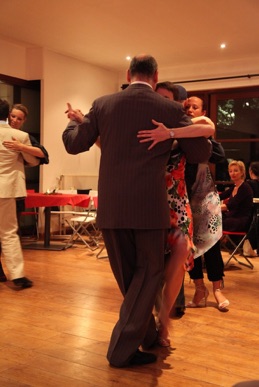Our milongas are TRADITIONAL : They follow the ‘codes’ as they’re still in use today in some milongas in Buenos Aires. They originate from the grand balls of the fourties, in which several hundred dancers were able to create a fluid circulation of the dance floor.



An elegant attire is also customary for milongas. The elegance and refinement of tango music is best reflected by wearing a suit and tie and elegant dresses. It will change your posture and your whole attitude while dancing and is, after all, also more pleasant to look at than sweaty t-shirts.
The Cabeceo
is a discrete invitation by exchanging de looks. A follower wishing to be invited will start to look around or to look precisely at the leader she would like to dance with (the mirada). After an exchange of looks with an equally interested leader, a small nod will confirm the mutual agreement to share a tanda (series) of tangos together. This clever way of inviting will spare any embarrassing moments for the leaders and is in fact not macho at all, but an invitation from both sides.
The basic principles listed below contribute to respect and courtesy necessary for a successful milonga. Sure, at first sight they might seem restrictive but you’ll notice very soon that they in fact ensure the pleasure of dancing for all participants. They are also explained in-depth during the classes and practice sessions of the club.
While dancing, the dancers pay attention to:
-
•respecting the dance floor, the circulation and fluidity of the ‘ronda’,
-
•respecting the other couples on the dance floor: we dance with our partner but ALSO with the other couples, especially the ones in front of us. Overtaking or changing the line of dance should not be done,
-
•not making backward steps, or dangerous figures,
-
•inviting by using the Cabeceo (more on this below),
-
•enjoying the cortinas (music between two series of tango) without dancing them.
Milonga Tango Social Club, April 2013



